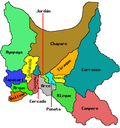Colomi Qulumi | |
|---|---|
| Coordinates: 17°21′0″S65°52′0″W / 17.35000°S 65.86667°W | |
| Country | |
| Department | |
| Province | Chapare Province |
| Municipality | Colomi Municipality |
| Canton | Colomi Canton |
| Population (2001) | |
• Total | 3,699 |
| Time zone | UTC-4 (BOT) |

Colomi (Quechua : Qulumi) is a locality in the Cochabamba Department in central Bolivia. It is the seat of the Colomi Municipality, the second municipal section of the Chapare Province. At the time of census 2001 it had a population of 3,699. [1]
Contents
In 2021, 21 people were killed in a bus crash.

